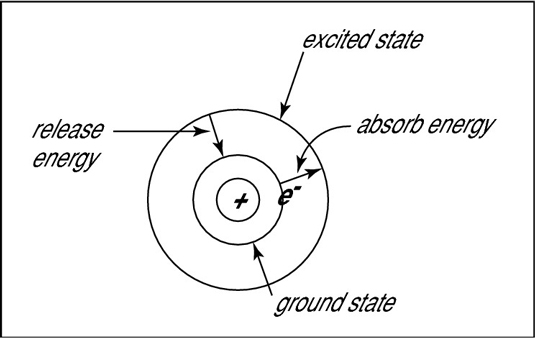A model is useful because it helps you understand what’s observed in nature. It’s not unusual to have more than one model represent and help people understand a particular topic.
Have you ever bought colored crystals for your fireplace to make flames of different colors? Or have you ever watched fireworks and wondered where the colors came from?Color comes from different elements. If you sprinkle table salt on a fire, you get a yellow color. Salts that contain copper give a greenish-blue flame. And if you look at the flames through a spectroscope, an instrument that uses a prism to break up light into its various components, you see a number of lines of various colors. Those distinct lines of color make up a line spectrum.
Niels Bohr, a Danish scientist, explained this line spectrum while developing a model for the atom:
-
The Bohr model shows that the electrons in atoms are in orbits of differing energy around the nucleus (think of planets orbiting around the sun).
-
Bohr used the term energy levels (or shells) to describe these orbits of differing energy. He said that the energy of an electron is quantized, meaning electrons can have one energy level or another but nothing in between.
-
The energy level an electron normally occupies is called its ground state. But it can move to a higher-energy, less-stable level, or shell, by absorbing energy. This higher-energy, less-stable state is called the electron’s excited state.
-
After it’s done being excited, the electron can return to its original ground state by releasing the energy it has absorbed, as shown in the diagram below.
-
Sometimes the energy released by electrons occupies the portion of the electromagnetic spectrum (the range of wavelengths of energy) that humans detect as visible light. Slight variations in the amount of the energy are seen as light of different colors.
 Ground and excited states in the Bohr model
Ground and excited states in the Bohr model
Bohr also found that the various energy levels can hold differing numbers of electrons: energy level 1 may hold up to 2 electrons, energy level 2 may hold up to 8 electrons, and so on.
The Bohr model works well for very simple atoms such as hydrogen (which has 1 electron) but not for more complex atoms. Although the Bohr model is still used today, especially in elementary textbooks, a more sophisticated (and complex) model — the quantum mechanical model — is used much more frequently.

